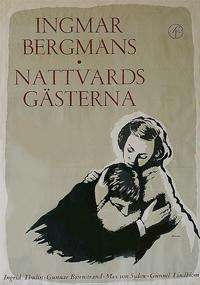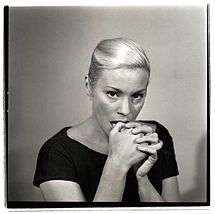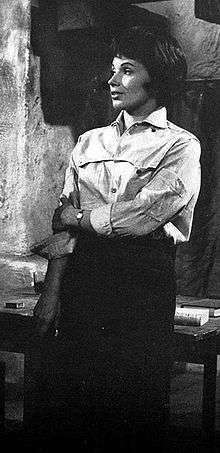Winter Light
| Winter Light | |
|---|---|
 Theatrical release poster | |
| Directed by | Ingmar Bergman |
| Produced by | Allan Ekelund |
| Written by | Ingmar Bergman |
| Starring |
Ingrid Thulin Gunnar Björnstrand Max von Sydow Gunnel Lindblom |
| Cinematography | Sven Nykvist |
Release dates |
|
Running time | 81 minutes |
| Country | Sweden |
| Language | Swedish |
Winter Light (Swedish: Nattvardsgästerna – "The Communicants") is a 1963 Swedish drama film written and directed by Ingmar Bergman and starring Bergman regulars Gunnar Björnstrand, Ingrid Thulin and Max von Sydow. The film follows Tomas Ericsson (Björnstrand), pastor of a small rural Swedish church, as he deals with an existential crisis and his Christianity.
The film is the second in a series of thematically related films, following Through a Glass Darkly (1961) and followed by The Silence (1963), which is sometimes considered a trilogy. Vilgot Sjöman's film Ingmar Bergman Makes a Movie was made simultaneously with Winter Light and documents its production.
Plot
In the final moments of Pastor Tomas Ericsson's noon service, only a handful of people are in attendance, including fisherman Jonas Persson and his wife Karin, and Tomas's ex-mistress, the atheistic Märta. After the service, Tomas, though coming down with a cold, prepares for his 3 o'clock service in another town. Before he leaves, however, the Perssons arrive to speak to him. Jonas has become morose after hearing that China is developing an atomic bomb. Tomas speaks to the man briefly, but asks Jonas to return after taking his wife home. No sooner have the Perssons left than substitute teacher Märta enters, and she attempts to comfort the miserable Tomas, and asks if he's read the letter she wrote to him. He has not, and tells her of his failure to help Jonas, and wonders if he will have anything to say, since he is without hope as well. Märta states her love for Tomas, but also her belief that he does not love her. She leaves, and Tomas reads her letter.
In the letter, Märta describes Tomas's neglect of her, relating a story of how a rash that disfigured her body repulsed him, and neither his faith nor his prayers did anything to help her. She writes of how her family was warm and loving without religion, and expresses bewilderment at his indifference to Jesus. Tomas finishes the letter, and falls asleep. Awakened by the return of Jonas, Tomas clumsily tries to provide counsel, before finally admitting that he has no faith as well. He says his faith was an egotistical one – God loved humanity, but Tomas most of all. Serving in Lisbon during the Spanish Civil War, Tomas could not reconcile his loving God with the atrocities being committed, so he ignored them. Tomas finally tells Jonas that things make more sense if we deny the existence of God, because then man's cruelty needs no explanation. Jonas leaves, and Tomas faces the crucifix and declares himself finally free.
Märta, who has been lurking in the chapel, is overjoyed to hear this, and embraces Tomas, who again does not respond to her affections. They are interrupted by the widow Magdalena, who tells them that Jonas has just committed suicide with a rifle. Tomas drives, alone, to the scene, and stoically helps the police cover Jonas's body with a tarp. Märta arrives on foot, and she and Tomas drive off to her home, where she invites him in to take some medicine for his cold. Waiting in Märta's classroom attached to her house, Tomas finally lashes out at her, telling her first that he rejected her because he was tired of the gossip about them. When that fails to deter her affections, Tomas then tells her that he was tired of her problems, her attempts to care for him, and her constant talking, and that Märta could never measure up to his late wife, the only woman he has ever loved. Though shocked by the attack, Märta agrees to drive with him to the Persson house. Informed of Jonas's suicide, Karin collapses onto the stairs and wonders how she and her children will go on. Tomas makes a perfunctory offer of help, and leaves.
Arriving for the 3 o'clock service at the second church, Tomas and Märta find the building empty except for Algot, the handicapped sexton, and Fredrik, the organist. Fredrik tells Märta that she should leave the small town and Tomas and live her life, rather than stay and have her dreams crushed like the rest of them. Meanwhile in the vestry, Algot questions Tomas about the Passion. Algot wonders why so much emphasis was placed on the physical suffering of Jesus, which was brief, versus the many betrayals he faced from his disciples, who denied him, did not understand his message, and did not follow his commands, and finally from God, who did not answer him on the cross. He asks, "Wasn't God's silence worse?" Tomas, who has been listening silently, answers yes. Fredrik and Algot wonder if they should have a service since no one showed up. Tomas begins the service.
Cast
- Gunnar Björnstrand – Tomas Ericsson, pastor
- Ingrid Thulin – Märta Lundberg, schoolteacher
- Gunnel Lindblom – Karin Persson
- Max von Sydow – Jonas Persson
- Allan Edwall – Algot Frövik, sexton
- Kolbjörn Knudsen – Knut Aronsson, warden
- Olof Thunberg – Fredrik Blom, organist
- Elsa Ebbesen – Magdalena Ledfors, widow
Themes
Ingmar Bergman identified previous films he had made with similar themes as The Virgin Spring (1960) and Through a Glass Darkly (1961).[1] Winter Light is often considered the second film in a trilogy, following Through a Glass Darkly and completed by The Silence.[2][3][4] All three films focus on spiritual issues. Bergman writes, "These three films deal with reduction. Through a Glass Darkly – conquered certainty. Winter Light – penetrated certainty. The Silence – God's silence – the negative imprint. Therefore, they constitute a trilogy."[5] He later retracted his claim the films form a trilogy.[5]
With Through a Glass Darkly ending with a discussion of how God is love, Winter Light further examines if understanding God is as simple as that.[6] Bergman stated he abandoned the idea that love is proof of God because it was unsatisfactory to explain to a character who was suicidal over fear of nuclear war.[7] The character Blom mocks the idea of God as love, attributing the words to Tomas but quoting the end of Through a Glass Darkly exactly.[8] Tomas's loss of his wife, and his loss of his ability to love, is further proof to him that God has become silent.[9] In contrast, the character Algot, presented as enlightened, equates Tomas's spiritual crisis with sayings of Jesus on the cross and God's "silence."[8]
Like Through a Glass Darkly, Winter Light describes God as a "spider-god," with Winter Light explaining the metaphor as God being responsible for suffering.[10] The ending may mean Tomas has decided God does not exist, or that Tomas learns he must keep his faith because all Christians, including Jesus, grapple with God's silence.[11] In Bergman's view, Winter Light represents his end with examining whether God exists, after which human love became his main concern.[11]
Production
Development
Director and screenwriter Ingmar Bergman was inspired to make the film after talking to a clergyman, who related how he had offered spiritual advice to a fisherman who later killed himself. To this, Bergman added the ideas of the clergyman struggling with his faith and a relationship outside marriage.[12] The idea of the character becoming depressed over fear of China and weapons of mass destruction was based on an article Bergman himself had read, and he acknowledged it reflected his own dread.[1]
Bergman attempted to structure the screenplay as chamber music, in three acts.[1] It is meant, in part, as criticism of the governance of the Church of Sweden, which Bergman felt was condemning itself by failing to keep what is important.[13] He completed the screenplay on 11 August 1961, at which point Vilgot Sjöman began filming the documentary Ingmar Bergman Makes a Movie chronicling the production.[14] With this film, Bergman took the rare step of sharing the screenplay with his father, Church of Sweden minister Erik Bergman, who he boasted read it three times. Ingmar may have been trying to communicate to his father that he understood Erik, but the name of the character, Ericsson (son of Erik), may indicate the character represented Ingmar more than Erik.[15]
Casting
Ingmar Bergman personally cast some of the roles himself.[16] Actor Gunnar Björnstrand, who played Tomas, typically acted in more comedic roles, and found it challenging to play a charcter who was in some ways unlikable. This led him to forget some of his lines, which Bergman said he had never seen Björnstrand do before.[12] However, Björnstrand told Sjöman he personally liked the character because of his relatability.[17]
Allan Edwall played Algot, a character with the same form of rheumatism as prop artist K.A. Bergman. As a result, K.A. Bergman supervised Edwall's performance.[18]
Filming
The film was shot between 4 October 1961 and 17 January 1962 in the Filmstaden studios, Skattunge kyrka with surroundings and Rättvik.[19] Although most film set have no roofs, the crew built a roof over the church it constructed.[20] K.A. Bergman brought in hymn boards, which were centuries old, from real churches in Forsbacka and Lillkyrka.[18]
Cinematographer Sven Nykvist's lighting was used directly from low perspectives in his shots.[4] To reduce the shadows as much as possible, Nykist had reflectors and screens built to also indirectly light scenes.[21] Although the clothing is ordinary, costume designer Max Goldstein had the actors try out many articles of clothing to determine what looked best, and Ingmar Bergman did not review his sketches.[22] The film employs no score aside from the organ music.[6][23] Bergman planned to use Sarabande from Suite No. 2 in D minor for Cello, BWV 1008 by Johann Sebastian Bach for the scene where Tomas and Märta leave the scene of Jonas's suicide, tying in with the use of the piece in Through a Glass Darkly, but Bergman eventually abandoned the idea as "contrived."[24]
Bergman judged the speed of filming to be slower than his average film, because of struggles to master the right emotions, though scenes did not require an unusually high number of takes.[25] The scene were Märta first comforts Tomas took 11 takes.[26]
Release
The film opened in Sweden on 11 February 1963.[27] Vilgot Sjöman's interviews with audience members at the Swedish premiere indicated viewers thought it was a masterpiece, that the performances were realistic, and Bergman's struggles with faith were relevant to everyone.[28]
In the United States, Winter Light opened in New York City on 13 May 1963, distributed by Janus Films.[29] On 19 August 2003, The Criterion Collection released the film on DVD in Region 1, in a boxset with Through a Glass Darkly, The Silence and Sjöman's documentary Ingmar Bergman Makes a Movie.[30]
Reception
Bosley Crowther, writing for The New York Times, called it "a thoughtful, engrossing, shocking film."[29] The Variety review called it "an extremely moving and fascinating film."[12] John Simon described it as "inferior Bergman" in The New Leader, but wrote it still "deserves to be seen."[12] The National Board of Review named it one of the Top Foreign Films in its 1963 Awards.[31]
In 2007, Roger Ebert added the film to his Great Movies list, citing its "bleak, courageous power."[2] In his 2015 Movie Guide, Leonard Maltin gave the film three and a half stars, calling it a "Powerful, penetrating drama."[3] Bergman cited Winter Light as his favorite among his films.[4] The film has an 80% rating on Rotten Tomatoes, based on 15 reviews.[32]
References
- 1 2 3 Sjöman, Vilgot; Bergman, Ingmar (1963). "The Script". Ingmar Bergman Makes a Movie. Sveriges Television.
- 1 2 Ebert, Roger (1 December 2007). "Winter Light". Rogerebert.com. Retrieved 2 November 2016.
- 1 2 Leonard Maltin, Leonard Maltin's 2015 Movie Guide, Penguin Group, 2014.
- 1 2 3 Harper, Dan (February 2005). "Winter Light". Senses of Cinema. Retrieved 2 November 2016.
- 1 2 Birgitta Steene, Ingmar Bergman: A Reference Guide, Amsterdam University Press, 2005, p. 39
- 1 2 Marc Gervais, Ingmar Bergman: Magician and Prophet, McGill-Queen's University Press, 2001, p. 77.
- ↑ William C. Pamerleau, Existentialist Cinema, Palgrave Macmillan, 2009, p. 124.
- 1 2 Gervais, p. 78.
- ↑ R. J. Cardullo, Writing about Film: A Reader, BrownWalker Press, 2016, p. 120.
- ↑ Pamerleau, p. 123.
- 1 2 Laura Hubner, The Films of Ingmar Bergman: Illusions of Light and Darkness, Palgrave Macmillan, 2007, p. 58.
- 1 2 3 4 Jerry Vermilye, Ingmar Bergman: His Life and Films, McFarland & Company Publishers, 2002, p. 114.
- ↑ Sjöman, Vilgot; Bergman, Ingmar (1963). "Postproduction". Ingmar Bergman Makes a Movie. Sveriges Television.
- ↑ Sjöman, Vilgot (1963). "The Script". Ingmar Bergman Makes a Movie. Sveriges Television.
- ↑ Frank Gado, The Passion of Ingmar Bergman, Duke University Press, 1986, pp. 281-282.
- ↑ Katherine Thomson-Jones, Aesthetics and Film, Coninuum International Publishing Group, 2008, p. 48.
- ↑ Sjöman, Vilgot; Björnstrand, Gunnar (1963). "The Script". Ingmar Bergman Makes a Movie. Sveriges Television.
- 1 2 Sjöman, Vilgot; Bergman, K.A. (1963). "The Script". Ingmar Bergman Makes a Movie. Sveriges Television.
- ↑ "Nattvardsgästerna (1962) – Filming locations". Swedish Film Database. Swedish Film Institute. Retrieved 23 February 2010.
- ↑ Alexis Luko, Sonatas, Screams, and Silence: Music and Sound in the Films of Ingmar Bergman, Routledge, 2016, p. 203.
- ↑ Sjöman, Vilgot; Nykvist, Sven (1963). "The Script". Ingmar Bergman Makes a Movie. Sveriges Television.
- ↑ Sjöman, Vilgot; Goldstein, Max (1963). "The Script". Ingmar Bergman Makes a Movie. Sveriges Television.
- ↑ Cardullo, p. 119.
- ↑ Luko, p. 206.
- ↑ Sjöman, Vilgot; Bergman, Ingmar (1963). "Filming, Part 2". Ingmar Bergman Makes a Movie. Sveriges Television.
- ↑ Sjöman, Vilgot; Bergman, Ingmar (1963). "Filming, Part 1". Ingmar Bergman Makes a Movie. Sveriges Television.
- ↑ Robin Wood, Ingmar Bergman: New Edition, Wayne State University Press, 2013, p. 324.
- ↑ Sjöman, Vilgot (1963). "The Premiere". Ingmar Bergman Makes a Movie. Sveriges Television.
- 1 2 Crowther, Bosley (14 May 1963). "Screen: 'Winter Light' by Bergman: Tale of Country Pastor Challenges Religion". The New York Times. Retrieved 2 November 2016.
- ↑ Janis, Jason (19 September 2003). "A Film Trilogy by Ingmar Bergman: the Criterion Collection". DVD Talk. Retrieved 30 October 2016.
- ↑ "1963 Award Winners". National Board of Review. Retrieved 2 November 2016.
- ↑ "NATTVARDSGÄSTERNA (WINTER LIGHT) (1962)". Rotten Tomatoes. Retrieved 2 November 2016.
External links
- Winter Light at the Internet Movie Database
- Winter Light at the Swedish Film Institute Database

- Winter Light at AllMovie
- Criterion Collection essay by Peter Cowie
- Reverse Shot essay by Michael Joshua Rowin
- Winter Light movie images
.jpg)

